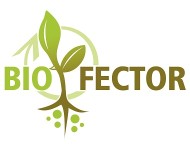| This MOOC is about Biofector. Please choose your language. In diesem MOOC geht es um Biofector. Bitte wählen Sie ihre Sprache. |

|

|

Video
QUIZit
What is the Goal of Biofector? (To bring fertilisers onto the world market (To control fertilising operations coutrywide (To reduce the amount of fertiliser used (To prohibit fertoliser use in Germany)
What are Biofectors? (Substances addictive for pests (Plants with no fertiliser (Microorganisms or Bio-Active Substances (Toxic Fertilisers)
Only 50% of nitrogen form normal fertilisers gets to the plant. How much phosphate does so? (90 % (60 % (20 % (40 %)
What can Biofectors do? (Destroy Pests (Act as a substitute for soil so that greenhouses can do without natural nutrients (Increase plant volume to produce giant plants (Stimulate plant growth by making nutrients available)
How Many Partners has Biofector? (22 Partners in 11 Countries (15 Partners in15 Countries (9 Partners in7 Countries)
What Sort of Partners Does Biofector Have? (8 Research Institutes, 10 Associations (7 Universities, 5 Research Institutes, 8 Firms und Associations (22 Firms from the Agro Sector)
In How Many Countries Does Biofector Perform Field Trials? (2 in Europe (8 in Europe (15 worlwise)
Was sind die wichtigsten Pflanzen für Biofector? (Carrot, Orange, Oats (Tomato, Wheat, Maize (Cucumber, Apple, Banana)
What Effects Were Observed in Field Trials, or What Effects were Desired? More Than One Correct Answer! (Increased Root Growth (Taller Plants (Increased Resistance to Pests (300 % greater Yield (Improved resistance to Stress (More Bio-Mass (Greater Efficiency)
.
Multiple-Choice
Was ist das Ziel von Biofector? (Düngemitteleinsatz reduzieren) (!Düngemittel auf den Weltmarkt bringen) (!Düngung in Deutschland zu verbieten) (!Düngung landesweit zu kontrollieren)
Was sind Biofectoren? (Mikroorganismen bzw. bioaktive Substanzen) (!Suchtmittel für Schädlinge) (!toxische Düngemittel) (!nicht gedüngte Pflanzen)
Es kommen nur 50 % des Stickstoffs bei einer herkömmlichen Düngung bei einer Pflanze an. Wie viel Phosphat kommt an? (20 %) (!60 %) (!90 %) (!40 %)
Was können Biofectoren? (Pflanzenwachstum stimulieren um Nährstoffe verfügbar zu machen) (!Pflanzenvolumen vervielfachen, damit Riesenpflanzen entstehen) (!Schädlinge abtöten) (!Erde ersetzen, damit Treibhäuser ohne natürliche Nährstoffe auskommen kann)
Wie viele Partner hat Biofector? (22 Partner aus 11 Länder) (!15 Partnert aus 15 Länder) (!9 Partner aus 7 Länder )
Welche Partner hat Biofector? (7 Universitäten, 5 Forschungsinstitute, 8 Firmen und Verbände) (!8 Forschungsinstitute, 10 Verbände) (!22 Firmen aus dem Agrarbereich)
In wie vielen Ländern macht Biofector Feldversuche? (8 in Europa) (!15 weltweit) (!2 in Europa)
Was sind die wichtigsten Pflanzen für Biofector? (Tomaten, Weizen ,Mais) (!Gurke, Apfel, Banane) (!Karotte, Orange, Hafer)
Welche Effekte wurden bei den Feldversuchen beobachtet bzw. werden angestrebt? Mehrere richtige Antworten! (erhöhtes Wurzelwachstum) (mehr Biomasse) (!höhere Pflanzen) (!300 % mehr Ertrag) (!erhöhte Schädlingresistenz) (verbesserte Stressresistenz) (mehr Effizienz)
.
Memory
| Erstelle ein Memory. Ersetze einfach die vorgegebenen Elemente. |
Memory-Titel
Finde die Paare.
| Bio- | -fector | - | Healthy growth, nutrient adequacy and | Resistance to stress factors | - | Algae, compost, and | Plant extracts | - | Maize, wheat and | tomato |
.
Lückentext
| Viel Spaß bei diesem Lückentext. |
BIOFECTOR is an integrated project with the aim to reduce input of mineral fertilisers in European agriculture by development of specifically adapted bio-effectors (BEs) to improve the efficiency of alternative fertilisation strategies, such as organic and low-input farming, use of fertilisers based on waste recycling products and fertiliser placement technologies.
Bio-effectors addressed comprise fungal strains of Trichoderma, Penicillium and Sebacinales, as well as bacterial strains of Bacillus and Pseudomonades with well-characterized root growth promoting and nutrient-solubilising potential. Natural extraction products of seaweed, compost and plant extracts, as well as their purified active compounds with protective potential against biotic and abiotic stresses are also tested in various combinations. These features offer perspectives for a more efficient use of nutrients by strategic combination with the alternative fertilisation strategies. Maize, wheat and tomato are chosen as representative crops. Laboratory and European-wide field experiments assure product adaptation to the various geo-climatic conditions characteristic for European agriculture.
The final goal is the development of viable alternatives to the conventional practice of mineral fertilisation as contribution to a more efficient management of the non-renewable resources of mineral nutrients, energy and water, to preserve soil fertility and to counteract the adverse environmental impact of agricultural production.
.
Offene Aufgaben & Projekte
- Schreibe eine Zusammenfassung darüber, wie Bioeffektoren funktionieren
Links
Kontakt
Universität Hohenheim
Prof Dr. Günter Neumann
Institut für Kulturpflanzenwissenschaften
70593 Stuttgart
www.biofector.info
Zuordnung
Autoren

